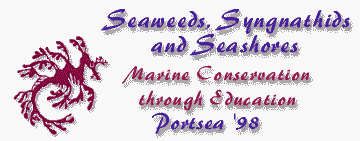 |
 |
Abstracts of Conference Papers
Workshops - Saturday
Seadragon Monitoring
|
"Into the Dragon’s Lair"
|
 |
Seadragons. The word sounds almost mythical, yet here in the southern Australia we are lucky enough to have two species, the leafy and weedy seadragon that are found nowhere else in the world.
The Dragon Search Project aims to encourage community involvement in monitoring a marine species and its habitat with the view to establish a data base of Seadragon sightings. This can be accessed by researchers and may assist in the establishment of marine protected areas in significant habitat areas.
This workshop undertook a Dragon Search under Queenscliff Pier.
"Experimental Learning in and for Marine Environments"
Assoc.Prof. John Nicholas & Students
University of Canberra
Canberra, 2601
 |
Whatever Marine Education or Environmental Education or indeed any worthwhile education means it means involvement of the learner in doing ( DEWEY). Teachers cannot be expected to involve their students in action based learning (FREIRE) - he died in May so get in quick before the conservative parties iconize him unless they’ve been there themselves. |
This workshop presented the experiences of a lecturer and his teacher education students of diverse curriculum backgrounds in attempting to put practical wheels (there are no other) on the idea of teaching/learning for the environment (LUCAS).
In attempting to 'environmentalise' a unit of teaching some remarkable learning occurred e.g. How would you have environmentalised theories of wave formation given: surf, metre sticks, wet suits, flippers, reel and line, etc?
This workshop contained action packed stories of success and failure in pushing students to the limit in learning in, through and for the environment and especially hot saline ones.
Swan Bay Discovery Tour
Mark Rodrigue
Education Officer
Marine Discovery Centre
Queenscliff
Combining outdoor adventure activities with environmental education provides educators with some great strategies for exploring and finding out about the environment. In this activity participants had the opportunity to learn the basics of canoeing while at the same time using the canoes to explore the diverse community of Swan Bay Marine Reserve.
A variety of sampling equipment was used on the trip to find out what lives in Swan Bay as well as consider some of the links between the Bay and the surrounding land.
Workshop 4
Swan Bay Integrated Catchment Management
Sue Longmore
Swan Bay Catchment FacilitatorRussell Irving
Coast Action Co-ordinator
Swan Bay is an internationally important wetland, teeming with life. The extensive seagrass meadows, rich mudflats and saltmarshes fringes provide food and shelter for a myriad of marine animals. This field trip highlighted the links between Swan Bay and its catchment, impacts on Swan Bay Marine Reserve and strategies implemented by urban and rural community groups to effect integrated catchment management.
Strategies included interpretive trails - the Swan Bay Environment Trail, foreshore and streamside restoration, water monitoring, stormwater awareness, wildlife corridors, management of significant roadside vegetation, wetlands enhancement, pest plant and animal control, practical resource materials and projects for schools and community awareness.
Student Monitoring Program
'What's going into the Oceans & Who's Doing It?'
A Catchment Study and Water Quality Analysis for School
and Community Groups.
Mrs. Leonie Hansen
Marine Studies Co-ordinator
Swansea High School
Park Avenue, Caves Beach
NSW 2281Workshop presenters: Michael Bailey, Trevor Cocksedge, Brendan Delaney, Shane Harding, Robert Hughes, Rebecca Young. Year 12 - 2 unit Marine Studies
With the ever-increasing population and technological pressure on the environment the waterways and associated estuaries and oceans of the world are becoming more and more the garbage dumps for the land. The physical appraisal of a catchment and chemical analysis of its waterways are important tools that can provide knowledge and understanding which can bring about change.
This workshop provided participants with the hands-on skills and enthusiasm needed to introduce this method of teaching to students and community groups. After the initial training students and community groups can move into the field and test sites throughout a catchment. If the number of participants performing the tests is greater than five, the test can be performed within an hour. The trained students and community groups can also become the teachers and train their peers in the testing and analysis of water.
Participants were taken along a tributary of Port Phillip Bay / Bass Strait in the Queenscliff area and identify the land uses of the area and possible sources of water pollution. They took water samples and test for phosphates, nitrates, dissolved oxygen, pH, temperature, turbidity, total dissolved solids and faecal coliform on location.
The results from both the catchment survey and water sample analysis were discussed producing a snap shot of the water quality and catchment issues. Ease of testing and quality of results will also be discussed.
Bay Litter Watch or Down the Drain
Bob Winters
Education Programs Manager
Gould League of Victoria
Genoa Street
Moorabbin 3189
|
In dealings with litter education for older students, the Gould League has identified three areas requiring attention. Schools need to put into place appropriate litter management strategies, students need to become more motivated not to litter and they need to clarify some of their values that cause them to litter. |
 |
Using a kit developed and produced by the Gould League, a teacher and their students can visit their closest beach and survey the rubbish. This workshop will look closely at how to apply practical skills, change students' attitudes, involve the local community and determine the impact litter has on the study area.